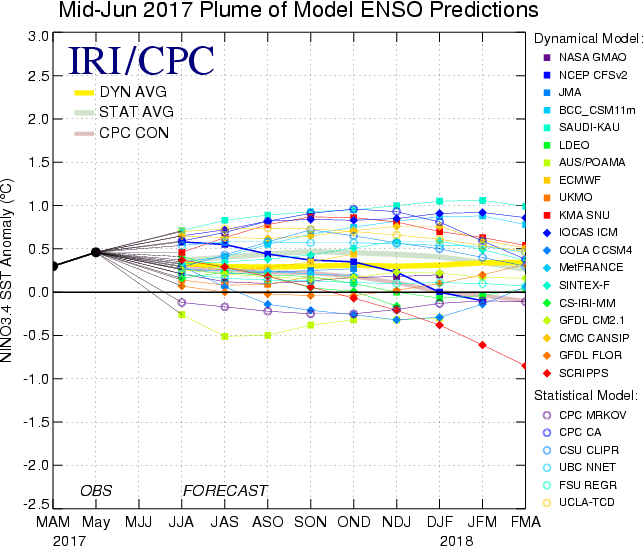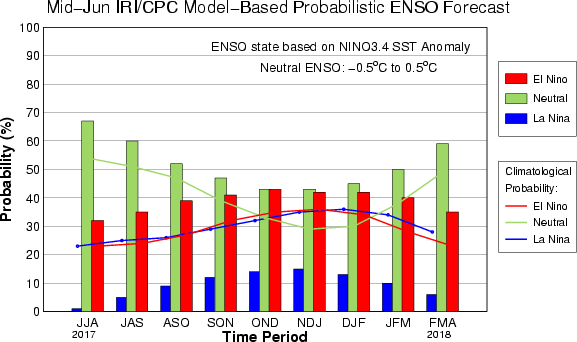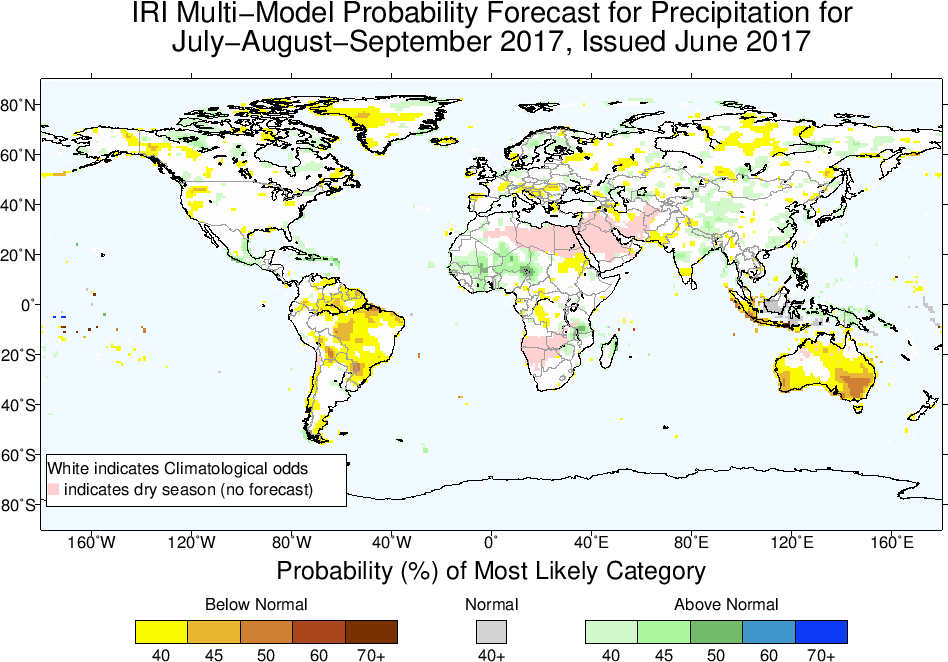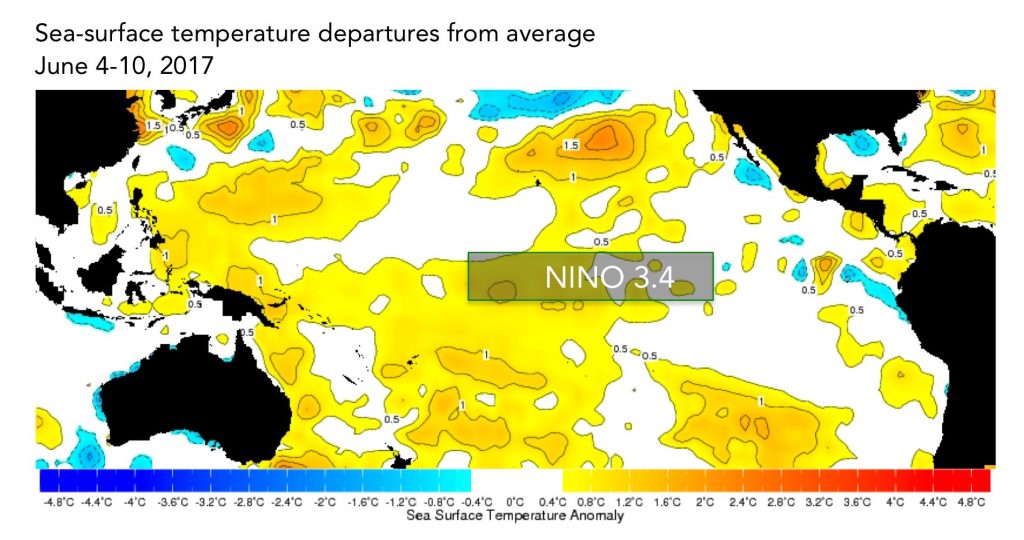June Climate Briefing: El Niño Odds Continue Downward Trend
Read our ENSO Essentials & Impacts pages for more about El Niño.
Tony Barnston provides an overview of the briefing
What’s New
Since last month’s briefing, weekly sea-surface temperature anomalies have been similar to the previous month’s temperatures, ranging from +0.4ºC to +0.6ºC in the area of the central equatorial Pacific Ocean that define El Niño and La Niña events, called the Nino3.4 region (see first image below). While these sea-surface temperatures (SSTs) are right at a borderline neutral-weak El Niño ENSO state, these weak anomalies do not equate to an El Niño event. For an El Niño event to be present, atmospheric indicators consistent with El Niño would also be required.
One of those atmospheric signs that could indicate a coming El Niño is the weakening or reversal of the tradewinds. The tradewinds have been close to average lately, so there is no strong evidence there for El Niño development.
Another early indicator of a forming El Niño is the presence of above-average temperatures in the ocean waters below the surface. The sub-surface temperature anomalies often portend what’s going to happen later at the surface, said Barnston. Like the tradewinds, these sub-surface temperatures have also been near average, so no hint from them of a lurking El Niño.
New seasonal forecasts: Our precipitation and temperature forecasts have a new methodology. More in this Q&A with our scientists.
While the models for the last few months were slightly favoring the development of an El Niño event, the odds are now tipped towards warm but neutral ENSO conditions for the remainder of the year. The exception is the October-December season, for which the odds for El Niño and neutral conditions are exactly even at just under 45% each.
The National Oceanic and Atmospheric Administration’s Climate Prediction Center’s ENSO alert system status is currently listed as Not Active.
ENSO Forecasts
To predict ENSO conditions, computers model the SSTs in the Nino3.4 region over the next several months. The plume graph below shows the outputs of these models, some of which use equations based on our physical understanding of the system (called dynamical models), and some of which use statistics, based on the long record of historical observations.
Despite the fact that SSTs are currently near the El Niño threshold, the model means predict the temperatures will not cross the threshold this year. The dynamical models call for Nino3.4 SSTs to decrease somewhat to an anomaly of around +0.3ºC for most of the forecast period, which is around 0.25ºC less than last month’s forecast. The statistical models’ mean is also down from last month, but just slightly. Those models predict the temperatures to be slightly warmer than the dynamical models’ forecast, but still at or below the +0.5ºC threshold.
This month comes towards the end of what’s known as the spring predictability barrier — a function of ocean dynamics that makes it hard to predict ENSO conditions past June of each year. Some uncertainty remains, but the spread of the model predictions has continued to tighten over the last several months. Most of the models fall within a 1.0ºC range, compared to around a 1.5ºC range last month and nearly 2.5ºC in April’s forecast.

This graph shows forecasts made by dynamical and statistical models for SST in the Nino 3.4 region for nine overlapping 3-month periods. Note that the expected skills of the models, based on historical performance, are not equal to one another.

The IRI/CPC probabilistic ENSO forecast issued mid-June 2017. Note that bars indicate likelihood of El Niño occurring, not its potential strength. Unlike the official ENSO forecast issued at the beginning of each month, IRI and CPC issue this updated forecast based solely on model outputs. The official forecast, available at http://1.usa.gov/1j9gA8b, also incorporates human judgement.
Based on these model outputs, odds for La Niña are around 15% or less for the rest of the year (see bar graph above). Neutral conditions are now generally the most likely ENSO outcome for the rest of the year, although the odds for neutral conditions and El Niño conditions are near even for the last few months of the year. Note that the probabilities in this figure don’t give an indication of the potential strength of an ENSO event.
ENSO in context: Resource page on climate variability
The official probabilistic forecast issued by CPC and IRI in early June indicates even less likelihood for an El Niño event. In that forecast, neutral conditions are the most likely outcome, with odds in the 50-55% range for the rest of the year. This early-June forecast uses human judgement in addition to model output, while the mid-month forecast relies solely on model output. More on the difference between these forecasts in this IRI Medium post.
Effects of La Niña on global seasonal forecasts
Each month, IRI issues seasonal climate forecasts for the entire globe. These forecasts take into account the latest model outputs and indicate which areas are more likely to see above- or below-normal temperatures and rainfall.

Despite the neutral ENSO forecast, some areas still have a tip of the odds towards drier- or wetter-than-average seasons. For the upcoming July-September season, Australia, South America and southwestern Indonesia show the strongest, widespread probabilities of increased chances for drier-than-normal conditions. Parts of western and southeastern Africa, as well as the Caribbean, carry some of the strongest probabilities for wetter-than-normal seasons. All forecast maps, including temperature in addition to precipitation, are available on our seasonal forecast page.
As of April of this year, these seasonal forecasts use a new methodology. The IRI probabilistic seasonal climate forecast product is now based on a re-calibration of model output from the NOAA’s North American Multi-Model Ensemble Project (NMME). The output from each NMME model is re-calibrated prior to multi-model ensembling to form reliable probability forecasts. The forecasts are now presented on a 1-degree latitude-longitude grid. More on this change on the seasonal forecast page, as well as in this Q&A with three of our climate scientists.
Learn more about El Niño and La Niña on our ENSO resources page, and sign up here to get notified when the next forecast is issued. In the meantime, check out #IRIforecast.


You must be logged in to post a comment.